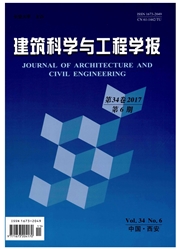

 中文摘要:
中文摘要:
为研究辅助墩对铁路悬索桥抗震性能及列车走行性的影响,以主跨828 m 的某单线铁路悬索桥方案为工程背景,建立了有限元模型,采用反应谱法和时程分析法对比研究了辅助墩对铁路悬索桥地震响应的影响。通过车-桥耦合振动分析,比较了不同位置辅助墩对桥梁和列车动态响应的影响。结果表明:设置辅助墩后,加劲梁的竖向地震反应明显减小,而桥塔的地震响应增大;车辆通过桥梁时,设置辅助墩后梁端竖向转角、车辆竖向加速度和轮重减载率均减小;当辅助墩位置向梁端移动时,梁端竖向转角、车辆竖向加速度及轮重减载率均逐渐减小,车辆响应对辅助墩纵向位置的变化不敏感。
 英文摘要:
英文摘要:
To investigate the influence of auxiliary piers on the seismic behavior and train runability of long-span railway suspension bridge ,a single-line railway suspension bridge with a main span 828 m was regarded as an example , and the finite element models were built . Meanwhile ,a comparative research on the influence of the auxiliary piers on seismic response of railway suspension bridge was carried out by using response spectrum method and time history analysis method .The dynamic responses of the train and bridge were compared under different locations of the auxiliary piers by analyzing the train-bridge coupling vibration .The results show that vertical seismic response of the stiffening girder is significantly decreased after setting auxiliary piers ,and the seismic response of the bridge towers is increased after setting auxiliary piers .The vertical rotation angle at girder ends ,the vertical acceleration and load reducing ratio of the train are decreased after setting auxiliary piers .The vertical rotation angle at girder ends , the vertical acceleration and load reducing ratio of the train are decreased as the auxiliary piers moving to the girder ends ,and the train responses are not sensitive to the changes of the auxiliary piers’ longitudinal position .
 同期刊论文项目
同期刊论文项目
 同项目期刊论文
同项目期刊论文
 期刊信息
期刊信息
